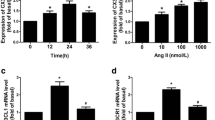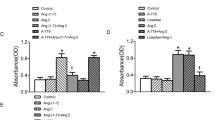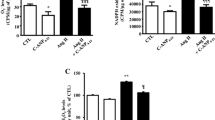Abstract
Nitroalkene derivatives of nitro-oleic acid (OA-NO2) regulate pluripotent cell signaling in vivo under physiological and pathological conditions. Angiotensin II type 1 receptor (AT1R) plays an important role in the cardiovascular system. In this study, OA-NO2 reduced the AT1R mRNA level, specifically in primary smooth muscle cells, showing a 70% reduction in rat smooth muscle cells (RASMCs) and a 50% reduction in pig smooth muscle cells (PASMCs). These effects were not observed in CHO cells, which highly express AT1R. The AT1R mRNA decay rate was unchanged after OA-NO2 compared with OA treatment. Nitric oxide (NO) and peroxisome proliferator-activated receptor gamma (PPARγ) did not alter the reduced effects of OA-NO2 on the AT1R mRNA level in SMCs. However, Sp1-mediated activation of the AT1R promoter was reduced in response to OA-NO2 in RASMCs but not 293T cells. In addition, the nuclear factor-kappa B (NF-κB) pathway was involved in the OA-NO2-mediated downregulation of AT1R transcription in SMCs. Taken together, our results demonstrate that OA-NO2 specifically inhibits AT1R mRNA expression in primary smooth muscle cells via the NF-κB pathway.
Similar content being viewed by others
References
Freeman, B. A., P. R. Baker, F. J. Schopfer, S. R. Woodcock, and A. Napolitano (2008) Nitro-fatty acid formation and signaling. J. Biol. Chem. 283: 15515–15519.
Nadtochiy, S. M., P. R. S. Baker, B. A. Freeman, and P. S. Brookes (2009) Mitochondrial nitroalkene formation and mild uncoupling in ischaemic preconditioning: Implications for cardioprotection. Cardiovasc. Res. 82: 333–340.
Schopfer, F. J. (2005) Fatty acid transduction of nitric oxide signaling. Free Rad. Biol. Med. 39: 8–8.
Cui, T., F. J. Schopfer, J. Zhang, K. Chen, and T. Ichikawa (2006) Nitrated fatty acids: Endogenous anti-inflammatory signaling mediators. J. Biol. Chem. 281: 35686–35698.
Wright, M. M., F. J. Schopfer, P. R. S. Baker, V. Vidyasagar, and P. Powell (2006) Fatty acid transduction of nitric oxide signaling: Nitrolinoleic acid potently activates endothelial heme oxygenase 1 expression. Proc. Nat. Acad. Sci. U.S.A. 103: 4299–4304.
Villacorta, L., J. Zhang, M. T. Garcia-Barrio, X. L. Chen, and B. A. Freeman (2007) Nitro-linoleic acid inhibits vascular smooth muscle cell proliferation via the Keap1/Nrf2 signaling pathway. Am. J. Physiol. Heart Circ. Physiol. 293: 770–776.
Zhang, J., L. Villacorta, L. Chang, Z. Fan, and M. Hamblin (2010) Nitro-oleic acid inhibits angiotensin II-induced hypertension. Circ. Res. 107: 540–548.
Chang, L. V., J. Zhang, M. T. Garcia-Barrio, K. Yang, M. Hamblin, S. E. Whitesall, L. G. D’Alecy, and Y. E. Chen (2009) Vascular smooth muscle cell-selective peroxisome proliferatoractivated receptor-gamma deletion leads to hypotension. Circulation 119: 2161–2169.
Rudolph, T. K., V. Rudolph, M. M. Edreira, M. P. Cole, and G. Bonacci (2010) Nitro-fatty acids reduce atherosclerosis in apolipoprotein E-deficient mice. Arterioscler. Thromb. Vasc. Biol. 30: 938–945.
Rudolph, V., T. K. Rudolph, F. J. Schopfer, G. Bonacci, and S. R. Woodcock (2010) Endogenous generation and protective effects of nitro-fatty acids in a murine model of focal cardiac ischaemia and reperfusion. Cardiovasc. Res. 85: 155–166.
Wright, M. M., J. Kim, T. D. Hock, N. Leitinger, and B. A. Freeman (2009) Human haem oxygenase-1 induction by nitrolinoleic acid is mediated by cAMP, AP-1 and E-box response element interactions. Biochem. J. 422: 353–361.
Batthyany, C., F. J. Schopfer, P. R. S. Baker, R. Duran, and L. M. S. Baker (2006) Reversible post-translational modification of proteins by nitrated fatty acids in vivo. J. Biol. Chem. 281: 20450–20463.
Tang, X., Y. Guo, K. Nakamura, H. Huang, and M. Hamblin (2010) Nitroalkenes induce rat aortic smooth muscle cell apoptosis via activation of caspase-dependent pathways. Biochem. Biophys. Res. Commun. 397: 239–244.
Elton, T. S. and M. M. Martin (2007) Angiotensin II type 1 receptor gene regulation: Transcriptional and posttranscriptional mechanisms. Hypertension 49: 953–961.
Sugawara, A., K. Takeuchi, A. Uruno, Y. Ikeda, and S. Arima. (2001) Transcriptional suppression of type 1 angiotensin II receptor gene expression by peroxisome proliferator-activated receptor- gamma in vascular smooth muscle cells. Endocrinol. 142: 3125–3134.
Li, D., T. Saldeen, F. Romeo, and J. L. Mehta (2000) Oxidized LDL upregulates angiotensin II type 1 receptor expression in cultured human coronary artery endothelial cells: The potential role of transcription factor NF-kappaB. Circulat. 102: 1970–1976.
Author information
Authors and Affiliations
Corresponding author
Additional information
These authors contributed equally to this work.
Rights and permissions
About this article
Cite this article
Wang, H., Ouyang, H., Tian, Y. et al. Nitro-oleic acid decreases transcription of the angiotensin II type I receptor gene in aortic smooth muscle cells. Biotechnol Bioproc E 19, 740–746 (2014). https://doi.org/10.1007/s12257-014-0255-6
Received:
Revised:
Accepted:
Published:
Issue Date:
DOI: https://doi.org/10.1007/s12257-014-0255-6




